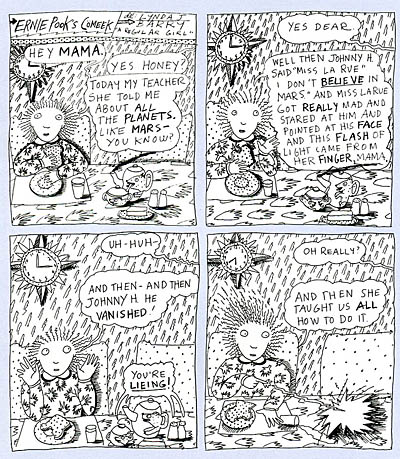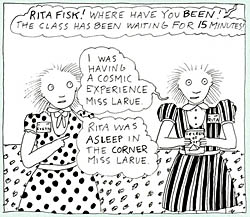 By Lynda Barry
By Lynda Barry
176 pages, black and white, with some color
Published by Drawn & Quarterly
Lynda Barry is one of those creators for whom I didn’t immediately gain an appreciation. The first couple of times I tried to read her syndicated strip Ernie Pook’s Comeek, it just didn’t click, and I shrugged and moved on. But then her books One! Hundred! Demons! and What It Is were published, and the two made me a huge convert. So when Drawn & Quarterly announced their multi-volume collection of Barry’s comics, I was both intrigued and a little scared. Would these old comics of Barry’s finally connect with me, or would it just reinforce my earlier opinion of her work? As it turned out? The answer was both.
 Blabber Blabber Blabber: Vol. 1 of Everything dives all the way back to Barry’s earliest comics in the late ’70s, and those earliest Ernie Pook’s Comeek are quite different from what was eventually to come. The comic eventually was taken over by Marlys, Maybonne, and company, but in these early days it’s primarily a series of one-off comics that are either 1- or 4-panel creations. Those who have never understood the title of Ernie Pook’s Comeek will be shocked to discover that Ernie Pook really was a character in those earliest strips, although there’s nothing particular to distinguish him from any other character that shows up in these early days. Comics often end in punch lines like, "I bet I’m getting future emotional disorder from this," or feature a tiny version of a person sitting on a tea cup. It’s a hugely varied strip that I think in some ways loses its effectiveness by being read in a collected edition; spread apart, the jokes and off-kilter humor has more of an impact, but in a rapid-fire state it’s hard to not notice a certain sameness. There are still winners in those early strips, though; every now and then Barry pulled a real winner out of nowhere, like the time a girl tells her mother about learning about the planets. With a particularly scratchy and primitive art style, it’s probably the least attractive to a casual reader, although the closer you look the more you can see what’s still to come from Barry.
Blabber Blabber Blabber: Vol. 1 of Everything dives all the way back to Barry’s earliest comics in the late ’70s, and those earliest Ernie Pook’s Comeek are quite different from what was eventually to come. The comic eventually was taken over by Marlys, Maybonne, and company, but in these early days it’s primarily a series of one-off comics that are either 1- or 4-panel creations. Those who have never understood the title of Ernie Pook’s Comeek will be shocked to discover that Ernie Pook really was a character in those earliest strips, although there’s nothing particular to distinguish him from any other character that shows up in these early days. Comics often end in punch lines like, "I bet I’m getting future emotional disorder from this," or feature a tiny version of a person sitting on a tea cup. It’s a hugely varied strip that I think in some ways loses its effectiveness by being read in a collected edition; spread apart, the jokes and off-kilter humor has more of an impact, but in a rapid-fire state it’s hard to not notice a certain sameness. There are still winners in those early strips, though; every now and then Barry pulled a real winner out of nowhere, like the time a girl tells her mother about learning about the planets. With a particularly scratchy and primitive art style, it’s probably the least attractive to a casual reader, although the closer you look the more you can see what’s still to come from Barry.
 Next are the Two Sisters strips, which (mostly) focus on twins Evette and Rita. There’s a bit of a through line for these stories in terms of the writing, and their want of a dog or their dealings with the world around them feels much more focused and interesting. It’s hard to not feel like these are the proto-Marlys and Maybonne, and Barry’s feeling out her idea of regular characters and how to work with them without getting bored. Barry’s art is going through a shift here, moving away from angular to rounded, and the way she draws the girls with their singular strands of hair standing out is an almost instantly more appealing visual style.
Next are the Two Sisters strips, which (mostly) focus on twins Evette and Rita. There’s a bit of a through line for these stories in terms of the writing, and their want of a dog or their dealings with the world around them feels much more focused and interesting. It’s hard to not feel like these are the proto-Marlys and Maybonne, and Barry’s feeling out her idea of regular characters and how to work with them without getting bored. Barry’s art is going through a shift here, moving away from angular to rounded, and the way she draws the girls with their singular strands of hair standing out is an almost instantly more appealing visual style.
The last section of the book are Girls and Boys strips, which shift back to a series of mostly unrelated strips, despite having a cast of characters. They’re less gag-oriented like the Ernie Pook’s Comeek strips at the start of the book, and at times they feel more like meditations on the world and people around Barry than something aiming for a specific point. This is also a section of the book that is primarily drawn in profiles (although it eventually shifts away from this style). It feels almost like you’re looking at cut-out puppets moving across the panels as a result, the characters never shifting away from the direction they initially face in, wiggling across the page. Add in the return of some of the tropes from Ernie Pook’s Comeek (I’m still a little unsure why Barry is so taken with the idea of miniature people appearing and talking to the characters, but it happens a lot), and Girls and Boys feels in many ways like a sequel to Ernie Pook’s Comeek, only with a slightly different art approach that is eventually abandoned.
I almost hate to admit that my favorite part of Blabber Blabber Blabber: Vol. 1 of Everything is the new material from Barry, as she explains in comic form how each portion of the book came about. From tracing R. Crumb comics to trying self-publishing for the first time, each anecdote is instantly gripping; Barry over the years has become an amazing storyteller. These earlier strips don’t quite hit that level, though, but the more you read, the more you begin to see flashes of what’s to come. Those deeply curious about Barry’s genesis as a comic creator will definitely want to buy Blabber Blabber Blabber: Vol. 1 of Everything, but in many ways I feel like this is for the die-hard fans. I’ll read more of the Barry collections because more than anything this has made me curious on how we get from these early days to the later parts of her career, or even just to the point where her regular cast of characters makes a debut. But while I found enough to enjoy here, I’m all right with waiting a bit for the next, inevitable release.
Purchase Links: Amazon.com | Powell’s Books
